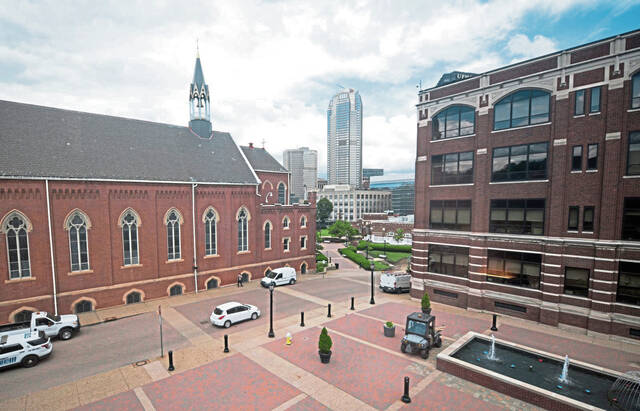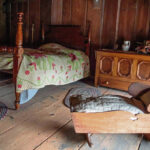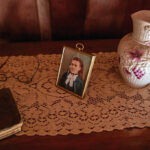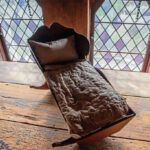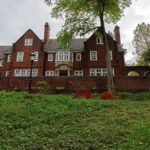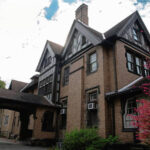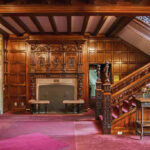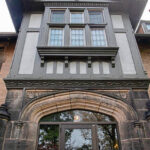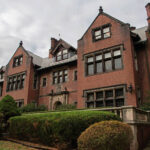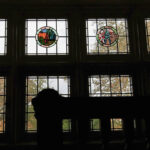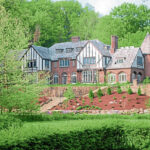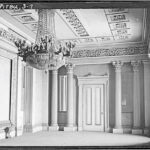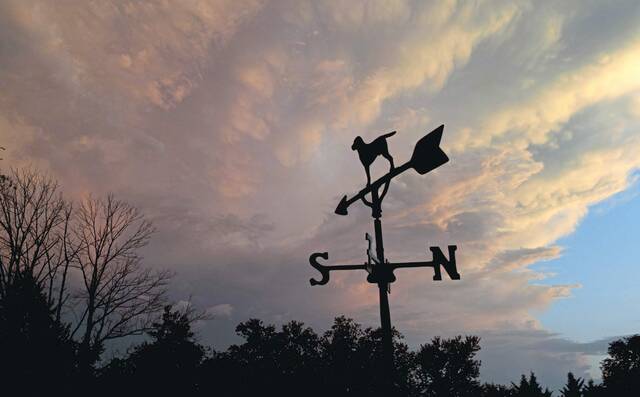The great thing about university ghost stories is that you don’t have to believe in the paranormal to derive a thrill from the tale, according to “Paranormal Pitt” author Matt Swayne.
Instead, you get “ghostlore,” — folklore that centers on ghosts or spirits — or stories where people claim to have experiences that they just can’t explain.
“In either case, these tales can be fun and maybe a little creepy, but you can learn a lot about the university’s history and culture,” said Swayne, who was born on Halloween and has always had an interest in horror movies and the otherworldly.
Chatham University
Chatham University sits just off Fifth Avenue in the Shadyside neighborhood of Pittsburgh. Many first-year students fall in love with the historical mansions that have been refurbished into dormitories. Long before the thought of starting a university existed, the mansions were the stomping grounds of Pittsburgh’s elite. Students today report that some of the buildings’ original owners have never left.
Fickes Hall
Fickes Hall, a freshman dormitory at Chatham, has long been rumored to be populated by a variety of spirits. One well-known apparition, Billy, appears in the form of a little boy. He has been known to bounce a ball down the halls of Fickes, startling Chatham newcomers.
Students have reported seeing Billy’s handprint on the door of a second-floor dorm room. Maintenance teams can never seem to hide the pesky hand-shaped stain no matter how many times they paint over it.
Built in 1927, Fickes was once the home of Edwin Stanton Fickes, known amongst his peers as an aluminum pioneer. His specter is believed to wander the halls of his old home looking for lost belongings after the building was donated to Chatham University in 1943 — less than a year after his death.
James and Julia Rea House
The James and Julia Rea House was built in 1912 and has a rumored history as the site of multiple extramarital affairs. Campus lore has it that Julia Rea and James Laughlin (the namesake for the dormitory building next door) carried on an affair. It’s been said the Laughlin House and Rea House were once connected by underground tunnels, which allowed for secretly going back and forth at night.
James Rea, Julia’s husband, discovered the affair and had a fight with Laughlin. According to the story, Laughlin soon after died by suicide.
All of this occurred while James Rea was rumored to have carried on his own affair with a woman on the housekeeping staff. When the young woman found out she was going to be fired, she hung herself in the Reas’ dining room. Legend has it she was pregnant at the time.
People have reported seeing a ghost appear to be hanging in the dining room area, along with hearing slamming doors and the cries of a baby. Students claim to feel the presence of the former owner, but no sightings have been reported of Laughlin.
Students also have reported seeing a female ghost who restlessly roams the halls.
Other reported phenomena include lights mysteriously turning on, doors slamming randomly, belongings disappearing and ghost sightings.
The Rea House basement is now the home of Rea Coffeehouse and is adorned with the graffiti and musings from decades of Chatham students.
The lore doesn’t exactly match with documented history, though.
The Laughlin and Rea families were closely entwined after Marjory Rea, James Rea’s sister, married H. Hughart Laughlin. The James Laughlin who helped found Chatham died in 1882 — four years before Julia Rea was born and 30 years before the Laughlin house was built as it stands today.
If Julia Rea was having an affair with a Laughlin, it was likely with her brother-in-law, James Laughlin III. Laughlin III was not recorded to have lived in the house.
According to Chatham University, the Marjory Rea Laughlin House was built in 1912. In 1967, the residence was donated to the university and became a home for 32 students. H. Hughart Laughlin, Marjory Rea Laughlin’s husband, owned part of the J&L Steel Corp., which James Laughlin started with Benjamin Jones in 1861.
The James and Julia Rea House was given to Chatham College in 1965 after the Reas had lived there for 53 years. James Childs Rea was a lifelong Chatham neighbor, having been born in what is now known as the Gateway House at the bottom of the hill on Fifth Avenue. In 1911, when he married Julia Parish Dodge, they built the 23-room, red brick house to start their own family. He and Julia raised eight children in the house.
Mellon Center
The Mellon Building was once the private home of Pittsburgh’s own Andrew Mellon. It included Pennsylvania’s first indoor swimming pool and a bowling alley. The Chatham community knows it as the Mellon Board Room in that space.
Over the years, students have reported the smell of cigar smoke wafting throughout the room. Others claim to have seen Mellon himself wandering the halls. Some faculty members say that even in death, Mellon hasn’t been able to give up his life of luxury. Students make a point to acknowledge Mellon’s portrait when they pass it. Campus lore warns that exams will be cursed if Mellon is ever angered.
University of Pittsburgh
Furniture that moves, a chandelier that swings without a breeze and a bedspread that repeatedly unmakes itself.
Visitors to campus have reported these freakish moments and more. But one spot on Pitt’s campus tops all others for paranormal activity — the Cathedral of Learning, the 42-story skyscraper in the center of Oakland.
Early American Nationality Room
“In just the sheer number of tales and accounts alone, the Cathedral’s Early American Room is one of Pitt’s most popular paranormal spots,” Swayne said.
The bed on display is said to have a recurring indentation, one that takes the shape of a human body.
“It’s like someone was sleeping on the bed,” Swayne said.
The indentation happens no matter how many times caretakers and tour guides straighten the covers.
According to The Pitt News, the late Nationality Rooms director Maxine Bruhns believed the “ghost” to be her late grandmother, a relation of writer Edgar Allan Poe, because it was her bedspread that was donated to the room. Bruhns loved to stir interest in the Early American Room and showcased the lore by hosting Halloween ghost watch events.
In that same room, a baby cradle seemingly rocks itself.
“People have entered the room and notice that the cradle is slowly rocking, as if some unseen hand is gently, but persistently, lulling a child to sleep,” Swayne said.
Croghan-Schenley Ballroom
The Croghan-Schenley Ballroom, also in the Cathedral, is said to never be at rest.
Situated on the first floor, the intimate room features a large wooden door and a hand-cut glass chandelier, which has been said to inexplicably start swinging even though nothing else in the room is disturbed.
The room was originally part of a mansion built in Stanton Heights in the 1830s by William Croghan Jr. for his daughter Mary, who eloped at age 15 with a British Army Captain who was 28 years her senior. She never danced in the ballroom.
The mansion was demolished and the ballroom and adjoining parlor were restored inside the Cathedral in 1982.
“In other stories, the morning crew finds furniture, often heavy furniture, moved or rearranged,” Swayne said. “Maybe ghosts need a change of scenery, too?”
Elsewhere on campus
Beyond the Cathedral, Pitt is awash with spooky ghost tales that include an Alumni Hall spirit dressed in a tux, a friendly ghost named Harriet said to haunt Bruce Hall and a phantom dancer engaged in a never-ending waltz in the Tansky Family Lounge in the William Pitt Union.
“Whether would-be ghost hunters find any evidence for real spirits on the University of Pittsburgh campus remains to be seen,” Swayne said. “But what people will find in these stories — and it’s probably why they’re so popular — are lessons in Pitt’s history and its culture.
“These stories embed the university’s values and its connection to the community. Students may come and go each semester, but these ghosts and their lessons will stay on forever.”
University of Pittsburgh — Greensburg
At least three spots with unexplained phenomena have been reported at Lynch Hall, a Tudor-style mansion housing administrative offices at Pitt’s Greensburg campus.
They include the basement area where voices were heard, directly below an office used by university president Robert Gregerson and formerly used by the home’s original owner, Commander Charles McKenna Lynch.
A U.S. Naval Academy graduate, Lynch served in World War I and World War II and was president of the Pittsburgh Stock Exchange. His estate, “Starboard Light,” was built on former Hempfield farmland, and Lynch died there in 1963.
Campus lore holds that Lynch’s spirit still is present at his former home, with some university staff reporting unnerving experiences.
Furniture has been rearranged, and doors have been reported to open and slam shut.
Duquesne University
With an institution so deeply rooted in history, it’s no surprise Duquesne University on the bluff in Downtown Pittsburgh has some haunted folklore.
The Duquesne Duke reported the building Des Places’ earliest history dates to 1909, as the Newsboys Home, an orphanage for young boys. When the Spanish Flu epidemic struck in 1918, the orphanage had many deaths.
Duquesne bought the building in 1961. It’s been said that the presence of some young boys who died when the building was an orphanage is still there. Reports include children laughing, unusual pranking behavior and rolling marbles.
While the original orphanage was torn down and the new Des Places dormitory was built on the site, reports of elevators closing and opening repeatedly have been made.
Duquesne also has some tall tales at the other end of its bluff, too. In the 1850s, the area where Old Main currently sits was an old hospital operated by Dr. Albert Walter. Walter was an abolitionist and used the hospital as a stop on the Underground Railroad, according to Duquesne archives.
One account recalls that an escaped slave who was very close to dying appeared on the doorstep of Walter’s hospital. Walter did his best to save him, but the slave passed away.
The Civil War began a few years later, and wounded soldiers and prisoners were taken to northern hospitals to recover. It’s said that wounded Confederate prisoners were sent to Walter’s hospital but he was not able to save them all. Walter died in 1876.
In 1882, the Holy Ghost Fathers purchased the old hospital and used the land to build Duquesne’s Old Main. They kept the old hospital building and moved it across the street, naming it St. John’s Hall. But that building, according to the tale, was haunted.
The story goes that the ghost of the former slave and the former Confederate soldier have fought in the bottom floor. Eventually, a priest grew tired of the noise and marched into the basement with holy water.
The priest yelled: “I’m coming to drive you out.” Legend has it the ghost replied: “Come ahead, I know all about you. You don’t scare me.”
The German priest, now very angry, charged down the basement stairs and grappled with the ghost. He doused the ghost in holy water, and it vanished. Disturbances have been said to lessen after that. In the early 1970s, the building was razed.














